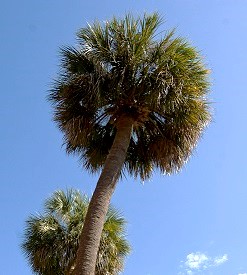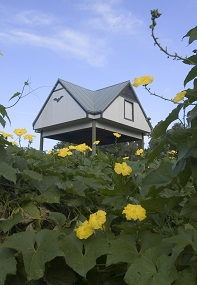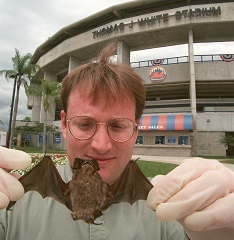
Note: All images were taken before 2020 as masks were not required before spring of this year.
The blood-sucking vampire bat stereotype of movie lore is not so scary in real life. In fact, the vampire bat does not even live in Florida. Vampire bats are native to South America and do not bite to “suck blood” as we’ve been lead to believe. With the structure of a bat’s wing being very similar to a human arm and hand, the Vampire bats will use the protruding claw of what would be a thumb-bone to scrape the ankle of a sleeping cow in a field and then lick the drops with their tongue. Not so scary, right?
Florida Native Bats
Not blood drinkers at all, our native Florida bats are not even as icky as that. This is the time of year when our attention, and some holiday decorating themes, seem to focus on the creepy, chill-inducing, less- than-photogenic side of bats. Superstition and “old wives’ tales” have also fed most Americans’ bat phobias. Though bats do NOT make good pets, hopefully this blog will give you a greater appreciation and understanding of Florida’s native bats as an important part of a healthy Florida ecosystem.
The Benefits of Bats
Here are some aspects of bats which should make all Florida residents appreciate them more:
- Bats may eat up to two thirds their own body weight in insects every night! Contrary to popular belief, mosquitoes are only a part of their diet, along with moths, beetles, flies, gnats, midges, winged ants, leafhoppers and many other plant and human pests.
- Florida bat species eat insects, except for a few rare visitors to south Florida which will eat fruit, nectar, or pollen.
- Bats are nocturnal, so you don’t have to see them if you don’t want to.
- They have 4 fingers & a thumb on each webbed “hand”.
- Bats are wonderful mothers, cradling their young close to their bodies.
- They are our only truly flying mammals.
- Florida bats are not rodents.
- They hunt their food using “echolocation” much like dolphins do.
- Bat guano (manure) is a natural fertilizer high in nitrogen and micro-nutrients.
- Most species of Florida bats are solitary creatures.
- Bats are great natural insect pest control for gardens.
- It is easy to create structures to attract bats to an area where you want them.
- There are 13 species of bats which live in Florida year-round, some of these species are considered endangered.
How can I Attract More Bats to my Neighborhood?

Several species of Florida bats live in tree cavities, snags, and under un-trimmed Sabal palm fronds. Rarely do they live in structures or house attics. To help native bats, keep your Sabal palms in a “lollipop” form and leave some dried fronds to hang down as shelter. A dead tree, or snag, one which presents no danger of falling on house or human, is a great bat habitat and woodpecker feeder.

There are many bat houses and bat house building plans available for purchase. Most of these are small structures which need to be placed at least 10 feet above the ground on a very stout pole. Be sure they are not just pretty, but are functional for our local bats. The University of Florida/Institute of Food and Agricultural Sciences (UF/IFAS) Electronic Data Information Source (EDIS) publication entitled, “Effective Bat Houses for Florida” is a great starting point for any Florida home-owner who wants to construct or buy a bat house for their property.
The UF Bat House & Bat Barns
The bat houses found on the University of Florida campus in Gainesville are quite impressive. Between the three bat house/barn structures, the UF campus bat house population is the largest in the world at over 400,000 bats. But how did UF become a bat-loving campus?
In 1987, the historic Johnson Hall building on the UF campus burned down. The large colony of bats which had been living in the attic of this building then began roosting under the concrete bleachers of the James G. Pressly Track & Field Stadium, causing a public health hazard. The University constructed a huge bat house in 1991 which became permanently occupied in 1995. UF has since constructed two other bat barns which now house that huge population of bats. With an adjacent observation area with educational kiosk, benches and fencing, “bat watching” during the evening colony emergence from the houses have become a popular local Gainesville wildlife experience. The Florida Museum in Gainesville has several videos of the UF main campus bats emerging from the bat houses at night HERE.

Don’t Bats Carry Rabies?
Only one in 200 bats test positive for rabies. However, unlike other mammals, rabid bats usually are not aggressive but become lethargic and are more likely found on the ground. The slow moving bats are easily picked up by children. It is very likely that bats found on the ground test positive for rabies. Never touch or pick up a bat found lying on the ground. Though these bats are insectivores, their teeth are very sharp. When they feel threatened or are sickened by disease, they may bite humans if handled. Contact a trained professional to handle or remove bats.
The UF/IFAS EDIS publication, “Bats of Florida”, has oodles of bat facts and tables listing the species of bats which live in or visit the state of Florida. It also lists where they prefer to roost, what area of the state they prefer, and a brief description of the bat species.
Ken Gioeli, pictured at right, is the UF/IFAS St. Lucie County Extension Natural Resources Agent. Ken has written numerous nature publications, including several blogs on Florida native bats. You may access his UF/IFAS St. Lucie County Extension Bat Blogs Here.
For more University of Florida EDIS publications on bats, check out the links below:
- “Bats of Florida”: https://edis.ifas.ufl.edu/uw203
- “Conservation of Bats in Florida”: https://edis.ifas.ufl.edu/uw291
- “Insect Pest Management Services Provided by Bats”: https://edis.ifas.ufl.edu/uw289
- “Effective Bat Houses for Florida”: https://edis.ifas.ufl.edu/uw290
- “Florida’s Bats: Florida Bonneted Bat”: https://edis.ifas.ufl.edu/uw426
- “Florida’s Bats: Brazilian Free-tailed Bat”: https://edis.ifas.ufl.edu/uw424
- “Florida’s Bats: Southeastern myotis”: https://edis.ifas.ufl.edu/uw433
- “Florida’s Bats: Velvety Free-Tailed Bat”: https://edis.ufl.edu/uw425
- “Facts about Wildlife Diseases: Bats and Coronaviruses”: https://edis.ufl.edu/uw473
 0
0
